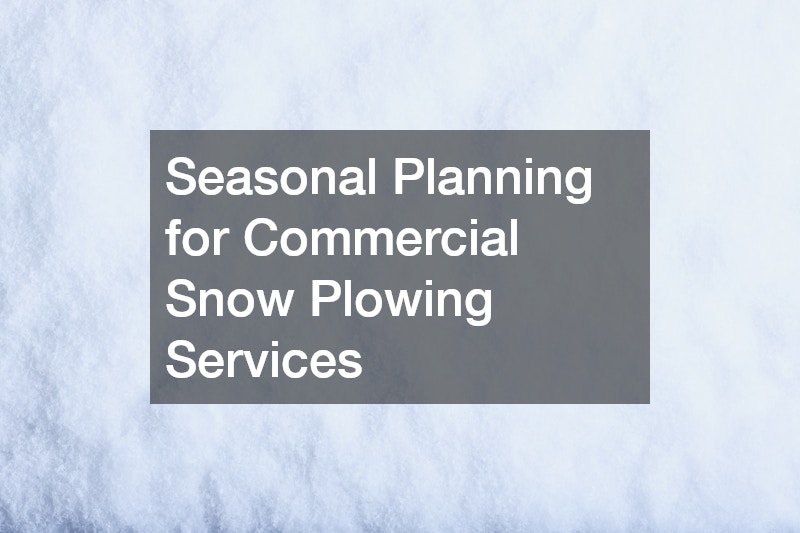
This article explores the essential aspects of seasonal planning for commercial snow plowing services. Proper planning ensures efficiency, safety, and customer satisfaction during the winter months.
Creating an effective snow removal plan starts with assessing the specific needs of your commercial property. This involves understanding the layout, the volume of snowfall expected in your region, and the urgency of snow removal based on operational hours.
Video Source
A comprehensive plan should also identify key areas that require immediate attention, such as entrances, walkways, and parking lots.
Following this assessment, it is essential to develop a snow removal timeline and procedure. This includes determining how often snow accumulation will be cleared, based on weather forecasts and snow accumulation rates. Having a clear timeline helps in allocating resources effectively and ensures timely service delivery to clients, minimizing potential disruptions to their operations.
Incorporating efficiency measures into your removal plan can further enhance service quality. This can involve scheduling regular equipment checks and maintenance to ensure reliability when the snow starts to fall. Furthermore, utilizing technology such as GPS tracking for routes can optimize plowing patterns and increase overall responsiveness during snow events.
The backbone of any commercial snow plowing operation is the right equipment. Essential machinery includes different types of plows, snow blowers, and payloaders. Investing in high-quality, durable equipment will ensure that snow removal is completed quickly and efficiently, even during heavy snowfall conditions. Moreover, vehicles equipped with appropriate plows can handle various snow types across different terrains.
Aside from the primary snow removal equipment, don’t forget the importance of safety gear for your team. This includes protective clothing, headlamps, and communication devices. Having the necessary gear not only promotes safety but also boosts team morale and efficiency in challenging conditions. Operators should be trained not only on how to use this equipment but also on its maintenance and daily safety checks.
Additional tools, such as salt spreaders and shovels, play a vital role in making the process easier and more efficient. These smaller tools can help with treating sidewalks and less accessible areas where larger snow plowing equipment may not fit. A diverse range of equipment is crucial to address the varying challenges of snow removal in commercial settings.
Pricing for commercial snow plowing services can be a complex process influenced by various factors. The location of the property is a primary determinant since suburban areas may require more resources than small urban lots. It's essential to conduct market research to understand your competition and ensure that your pricing is competitive yet profitable.
Another aspect influencing pricing includes the services offered beyond basic snow removal. Additional services could include salting and snow hauling, which can impact your pricing structure significantly. Offering a combination of services as a package can be attractive to clients, but the pricing should be reflective of the actual work involved and the benefits to the customer.
Moreover, contractual agreements play a critical role in how pricing is determined. Long-term contracts may allow for discounted pricing as well as the establishment of reliable income streams for your business. Clearly outlining the terms of service, pricing structures, and any potential extra fees in the contract can foster transparency and build trust with clients.
Establishing safety protocols for snow plowing services is crucial for ensuring the well-being of both employees and clients. One of the first steps is to implement training programs that educate workers on safe plowing practices and awareness of hazardous conditions. Proper training can significantly reduce accidents and injuries during snow removal operations.
In addition to training, it is vital to adhere to proper maintenance schedules for all snow removal equipment. Well-maintained vehicles and equipment assure not only the safety of workers but also the effectiveness of plowing operations. Regular checks should include brakes, lights, and plowing mechanisms to ensure everything functions properly when needed.
Finally, having a clear communication plan in place is essential. This can involve using radios or other communication devices to keep in contact with team members while they work. Moreover, establishing a system for reporting any safety concerns or incidents can help mitigate risks and foster a culture of safety in your company.
In other words, effective seasonal planning for commercial snow plowing services involves creating a solid plan, equipping the right tools, setting appropriate prices, and establishing safety protocols. This proactive approach will lead to successful winter operations. By investing time in these strategies, snow plowing services can operate efficiently and effectively, ultimately enhancing customer satisfaction and safety.
